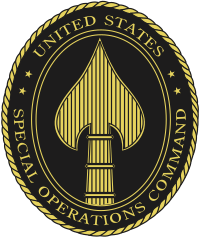
Back قيادة العمليات الخاصة للولايات المتحدة Arabic ABŞ Xüsusi Əməliyyatlar Komandanlığı Azerbaijani USSOCOM Danish United States Special Operations Command German Mando de Operaciones Especiales de los Estados Unidos Spanish فرماندهی عملیات ویژه ایالات متحده آمریکا Persian United States Special Operations Command French פיקוד המבצעים המיוחדים של ארצות הברית HE Zapovjedništvo za specijalne operacije (SAD) Croatian United States Special Operations Command Italian
| United States Special Operations Command | |
|---|---|
 United States Special Operations Command Emblem | |
| Founded | April 16, 1987 (37 years, 9 months ago)[1] |
| Country | |
| Type | Unified combatant command Special operations forces |
| Role | Functional combatant command |
| Size | Entire command: more than 70,000[2][3] Headquarters staff: 2,500[2] |
| Part of | United States Department of Defense |
| Headquarters | MacDill Air Force Base Florida, U.S. |
| Nickname(s) | USSOCOM, SOCOM |
| Engagements | Operation Earnest Will Invasion of Panama Gulf War Unified Task Force |
| Website | www.socom.mil |
| Commanders | |
| Commander | General Bryan P. Fenton, USA[5] |
| Deputy Commander | Lieutenant General Sean M. Farrell, USAF |
| Vice Commander | Lieutenant General Francis L. Donovan, USMC[6] |
| Senior Enlisted Leader | Command Sergeant Major Shane W. Shorter, USA[7] |
| United States Armed Forces |
|---|
 |
| Executive departments |
| Staff |
| Military departments |
| Military services |
| Command structure |
The United States Special Operations Command (USSOCOM or SOCOM) is the unified combatant command charged with overseeing the various special operations component commands of the Army, Marine Corps, Navy, and Air Force of the United States Armed Forces. The command is part of the Department of Defense and is the only unified combatant command created by an Act of Congress. USSOCOM is headquartered at MacDill Air Force Base in Tampa, Florida.
The idea of an American unified special operations command had its origins in the aftermath of Operation Eagle Claw, the disastrous attempted rescue of hostages at the American embassy in Iran in 1980. The ensuing investigation, chaired by Admiral James L. Holloway III, the retired Chief of Naval Operations, cited lack of command and control and inter-service coordination as significant factors in the failure of the mission.[8] Since its activation on 16 April 1987, U.S. Special Operations Command has participated in many operations, from the 1989 invasion of Panama to the War on Terror.[9][10]
USSOCOM is involved with clandestine activity, such as direct action, special reconnaissance, counter-terrorism, foreign internal defense, unconventional warfare, psychological warfare, civil affairs, and counter-narcotics operations. Each branch has a distinct Special Operations Command that is capable of running its own operations, but when the different special operations forces need to work together for an operation, USSOCOM becomes the joint component command of the operation, instead of a SOC of a specific branch.[11]
- ^ Cite error: The named reference
2013 SOCOM Fact bookwas invoked but never defined (see the help page). - ^ a b Cite error: The named reference
2020 SOCOM Fact bookwas invoked but never defined (see the help page). - ^ Paul McCleary (21 May 2019) SOCOM Pivots Toward Great Power Competition Archived 25 May 2019 at the Wayback Machine reports SOCOM strength to be 70,000
- ^ "U.S. Soldier Dies in Raid to Free Prisoners of ISIS in Iraq". The New York Times. 22 October 2015. Archived from the original on 24 October 2015. Retrieved 24 October 2015.
- ^ "Commander, USSOCOM, General Bryan P. Fenton". U.S. Special Operations Command. Retrieved 30 April 2023.
- ^ "Vice Commander, USSOCOM, Lieutenant General Francis L. Donovan". U.S. Special Operations Command. Retrieved 30 April 2023.
- ^ "Senior Enlisted Leader, USSOCOM, Command Sergeant Major Shane W. Shorter". U.S. Special Operations Command. Retrieved 30 April 2023.
- ^ Cite error: The named reference
Adm Holloway biowas invoked but never defined (see the help page). - ^ Cite error: The named reference
NYT Bang Panamawas invoked but never defined (see the help page). - ^ Cite error: The named reference
NYT Regime thoughtwas invoked but never defined (see the help page). - ^ Cite error: The named reference
posture statementwas invoked but never defined (see the help page).